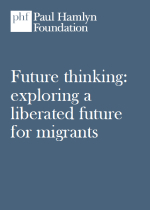Study on runaway children in India published
The PHF India programme has published a report on the lives of runaway children in India.
‘Lost Childhoods: A study on platform children and other children in distress’ provides an assessment of the current situation and discusses different approaches to helping improve the lives of runaway and platform children.
In India, more than 44,000 children are reported missing every year. Of these, around 11,000 remain untraced. As many cases go unreported, it is thought the actual numbers of missing children are much higher. Missing children often end up on the streets, contributing to the country’s 11 million street children. In each of Delhi, Mumbai and Kolkata, estimates put the number of missing children who are street children at between 100,000 and 125,000. They come from all over India to find work, escape ill treatment at home or simply follow the lights of the city, which promises a better life. Many of them land on the country’s railway platforms, where they beg, steal or do menial jobs, such as sweeping trains, to survive. Very often, they fall victim to child traffickers.
Interest in the fate of street children in India increased after the release of Salaam Bombay, a movie depicting the life of children on the streets of Mumbai. This led to the emergence of NGOs that provided contact points, drop-in centres and night shelters to street children. In 1989, the UN Convention on the Rights of the Child introduced the notion of ‘best interest of the child’ which is meant to inform all actions pertaining to children. This not only gave children basic human, civil, economic, social, cultural and political rights but also paved the way for a more ‘activist’ engagement for their rights. Protection and rehabilitation of runaway children is now the primary concern of organisation working in this field.
‘Lost Childhoods’ traces the development of Indian and international policy and legislation regarding children in need of care and protection as well as children in conflict with the law, focusing on runaway and missing children. The report addresses the persistent issue of child labour, discusses trafficking of children for sexual activities and provides insights into developments regarding juvenile crime in India. Drug abuse by children is also highlighted as a particularly concerning phenomenon.
Research has found that railway stations, as places of transit, source and destination, are breeding grounds for child labour and child trafficking and exploitation. The situation of children living in railway stations and on platforms is often overlooked. However, the report identifies some positive developments, such as a set of recommendations made by the National Commission for Protection of the Child Rights (NCPCR) in 2010 and a petition against the Ministry of Railways, demanding a system that care for children in distress.
A number of case studies complement the report’s general overview, providing detailed accounts of three approaches used by organisations to improve the lives of runaway children. The first of these is based on the belief that children have a right to a safe and happy home and seeks to reunite runaway children with their families. The second approach puts protection and rehabilitation at its heart, providing safe spaces as well as basic education, counselling, creative activities and medical aid. The third approach seeks to encourage children to participate in their own development by making them take part in decision-making in programme planning, monitoring and evaluation, while providing safe spaces and opportunities.
‘Lost Childhoods’ also makes a number of recommendations for PHF’s future strategy in India. It suggests that the Foundation continue to support NGOs directly working with children in distress, while exploring potential funding of more innovative NGOs that are collaborating with educational institutions to provide vocational training or fellowship to children who want to train or study further. The report also encourages PHF to support research on children in distress, to improve the knowledge base about this vulnerable group.
In its strategic plan for 2013-18, the PHF India programme has identified a number of groups of especially vulnerable people it seeks to help improve their lives. It will focus on one of these in each of the coming years. This year, the programme has initiated work on runaway children and child labour. It draws upon systematic studies and input from experienced people who understand the larger picture to gain a clearer perspective on the current situation and on the approaches and directions that need to be taken to address issues of concern.


